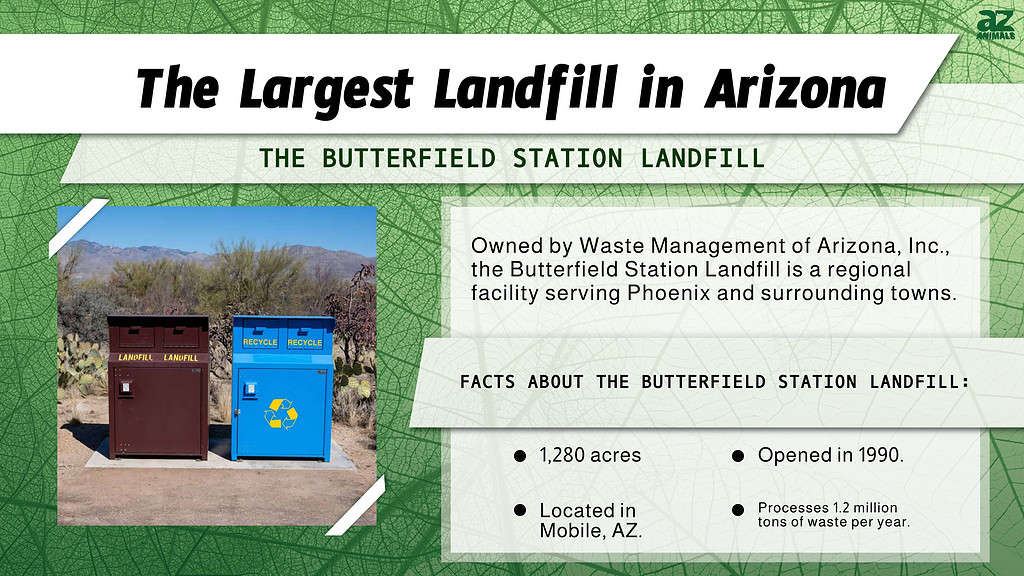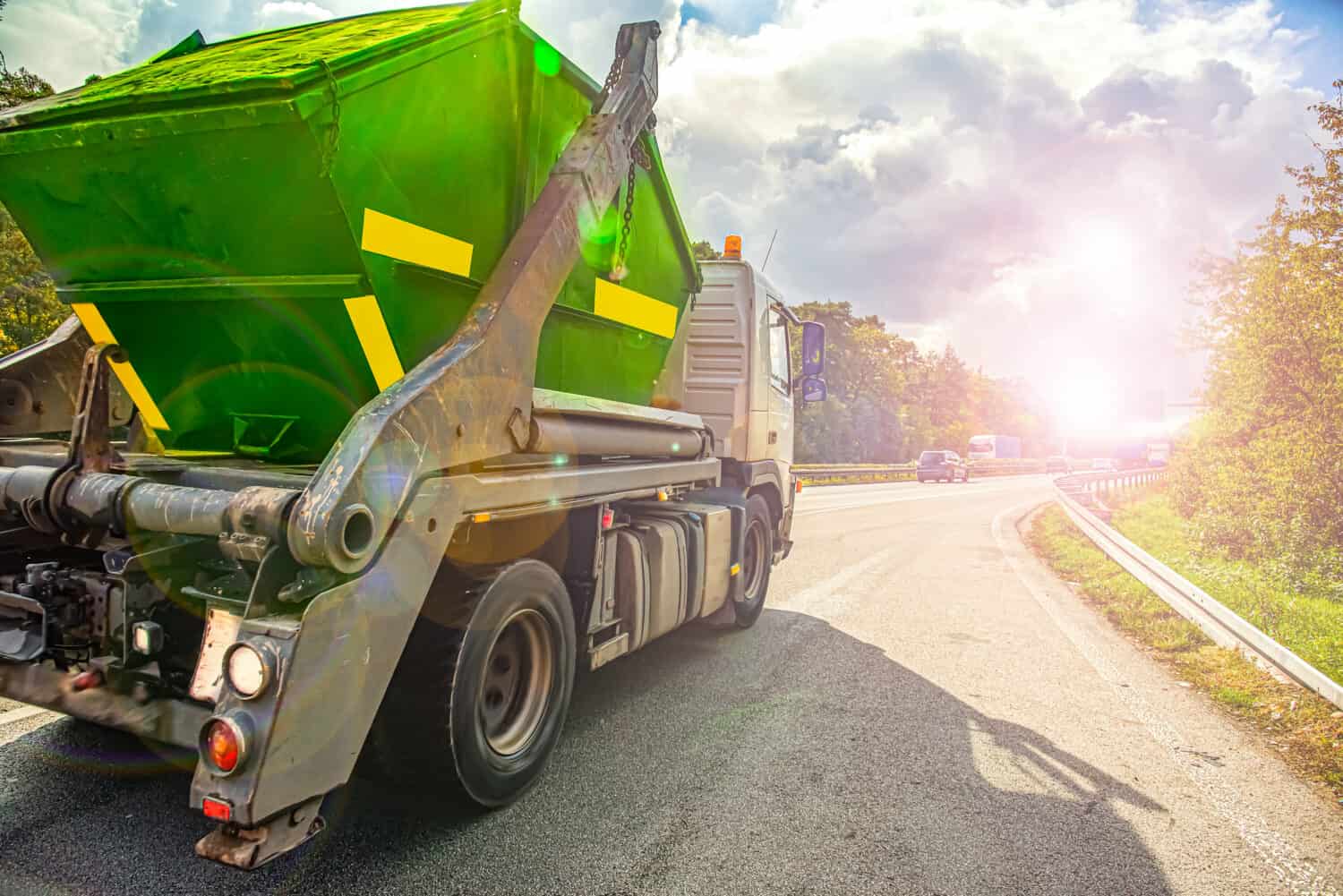Landfills get rid of solid waste in closely-managed, well-engineered locations. In order to assure that they adhere to federal guidelines, landfills are strategically placed, planned, operated, and inspected. Today, we’re going to be looking at the Butterfield Station Landfill, which is the largest in Arizona.
They design landfills to protect the environment against toxins that could be in the stream of waste. Environmentally sensitive locations cannot be used for the construction of landfills, which are situated using on-site environmental monitoring equipment.
In addition to providing extra security, these monitoring devices look for any indication of contamination of groundwater and gas from landfills.
The Largest Landfill in Arizona

Butterfield Station Landfill is the largest landfill in the state. This 1,280-acre landfill first opened for business in 1990. It processes roughly 1.2 million tons of waste a year. Waste Management of Arizona, Inc. owns this landfill.
A regional site, Butterfield Station Landfill offers neighborhoods, companies, and enterprises in the Phoenix metro area and neighboring cities safe and practical disposal solutions. It is located in Mobile, AZ.
This plant is subject to stringent surveillance and communication requirements and is designed with environmental protection measures that meet or exceed strict limits set by the government.
Leachate collection and elimination, landfill gas collection and oversight, and designed liners and coverings are examples of systems. By using a flare system to capture and control landfill gas, Butterfield Station lowers smells and emissions.
Where Is Mobile, Arizona, Located on a Map?
Mobile, also known as Sonoran Valley, is 35 miles southwest of Phoenix. It is in Maricopa County, in the planning area of Goodyear, Arizona, a Phoenix suburb. There are less than 100 people in Mobile, but there are lots of landfills around it.
How Many Landfills Are in Arizona?
Arizona currently has a single operational landfill project, 18 candidate landfills, and 40 landfills in total. The most populous Valley cities, according to data gathered over the last five years, have all failed to raise landfill diversion rates. None even come anywhere near the U.S. Environmental Protection Agency’s most recent figure of a national average of 35%.
The rates are also significantly lower than those of many Western American towns, especially those in California, where regulations, financial incentives, and various approaches to measuring diverted garbage have led to rates that are three or four times greater than those of Arizona’s largest cities.
Phoenix is the best example of the difficulties Arizonan cities face when it pertains to recycling. In the fiscal year 2014–15, the city’s residential waste disposal rate was 20%. According to statistics the city supplies, the actual percentage is closer to 14% when all rubbish that is brought right to city transfer stations by contractors, construction workers, and people who drop off goods is included.

The local government plays a big role in waste management.
©https://commons.wikimedia.org/wiki/File:Arizona_State_Capitol_building_(52619864371).jpg
What Risks Do Landfills Present to Arizona?
The rightful disposal of solid waste requires landfills. They keep towns clean, lessen the amount of rubbish that enters the environment, and aid in the prevention of disease. But landfills continue to have a large negative influence on the environment and society.
Although landfills are a sociological need, there are ways to lessen our dependency on them and their negative impacts on the environment.
Toxic Gases
The emission of methane gas from landfills is the primary environmental issue. Methane gas is generated during the breakdown of organic material in landfills. Methane is among the most powerful greenhouse gases and a major cause of climate change since it is 84 times stronger than carbon dioxide at capturing heat from the sun.
In addition to methane, landfills also release water vapor, carbon dioxide, and a small quantity of oxygen, nitrogen, and other non-methane organic molecules. If not under control, these gases may additionally play a role in climate change and lead to pollution.

Along with viruses and bacteria, harmful gases and pollutants can cause harm to humans and animals.
©nEwyyy/Shutterstock.com
Destroying Nature
In general, the construction of landfills results in the destruction of wildlife’s surroundings. A landfill typically covers 600 acres. There are currently over 3,000 operational landfills in the US, which has resulted in the loss of up to 1,800,000 acres of habitat.
Federal law mandates that landfills have a synthetic or clay lining, yet these liners frequently leak. As a result, neighboring water sources may become contaminated with leachate, a liquid generated by landfills, which further harms ecosystems.
Ammonia concentrations in leachate can be very high. Ammonia is nitrified to form nitrate when it enters ecosystems. Eutrophication, or a shortage of oxygen as a result of enhanced growth of plants, might then result from this nitrate in neighboring water sources.
Because of a shortage of oxygen, eutrophication causes “dead zones” where wildlife is unable to survive. Leachate also contains toxic substances like mercury since hazardous items are present in landfills in addition to ammonia.
Harming Humans
People who live and work close to landfills are at risk for health problems because of waste emissions. According to a study in New York State, there is a 12% higher chance of congenital abnormalities in babies born to families that live less than one mile from a toxic waste landfill.
Hazards associated with landfills include odor, smoke, noise, pests, and tainted water supplies. Landfills and dangerous waste dumps have a greater probability to be located in minority and low-income regions.
Less money is available in these places to protest the construction of these amenities. Compared to higher-income communities, they are a simpler target for landfill installation.
Who Owns the Landfills in Arizona?

The City of Phoenix owns that Public Works State Route 85 Landfill.
©yaalan/Shutterstock.com
Many individuals, businesses, and even cities can own a landfill. The Public Works State Route 85 Landfill is 2,652 acres of land that the City of Phoenix currently owns. Maricopa County owns the roughly 80 acres that Queen Creek Landfill uses.
To help you with disposal service, Pinal County has a number of venues. Please be aware that Pinal County does not own these facilities. Arizona Waste Management also owns a number of them.
According to a report, towns nationwide spent roughly $2.3 billion on disposing of plastic in 2019, and the market value of landfilled plastic is predicted to be between $4.5 billion and $9.9 billion, or $7.2 billion overall.
Municipal solid waste dumps charged $53.72 per ton in typical tipping fees in 2020. This amounts to an average annual gross revenue of $1.4 million in the case of small landfills and $43.5 million for larger landfills, and that’s just from gate fees! You know what they say – one man’s trash is another man’s treasure.
What Wildlife (Or People) Live near This Landfill?

Coyotes roam around the entire state!
©iStock.com/dmodlin01
Mobile, AZ, is roughly 35 miles from Phoenix. One of the positives about the Butterfield Station Landfill is that it’s in a town with less than 100 residents. This area has quite a unique history. With nearly 400 residents by the 1950s, the town was thriving, but the absence of jobs, running water, and educational opportunities caused the majority of the original settlers and their offspring to leave.
In addition to human life, there are still plenty of animals that call the area home.
You can spot coyotes all over the state and are present in almost all of Arizona’s natural state parks. The collared peccary, sometimes known as the javelina, is one of the most unusual wildlife species that frequent Arizona.
These foul-smelling, pig-like critters don’t mind being around people and make loud grunting noises. Mobile, AZ, is home to both of the deer species that are native to Arizona.
Whitetail deer and mule deer normally inhabit slightly different environments, while there is often overlap between the two species in this region of the state.
The coati, or coatimundi, is frequently misidentified as desert monkeys due to their long tails and preference for trees, although in reality they are more directly related to raccoons. These sociable creatures are fascinating to observe and live in many of Arizona’s state parks.
Speaking of, you can find raccoons all around Arizona. They can live almost everywhere there is a reliable source of water, including in the desert! It is undeniable that these little thieves enjoy trash!
The photo featured at the top of this post is © leshiy985/Shutterstock.com
Thank you for reading! Have some feedback for us? Contact the AZ Animals editorial team.






